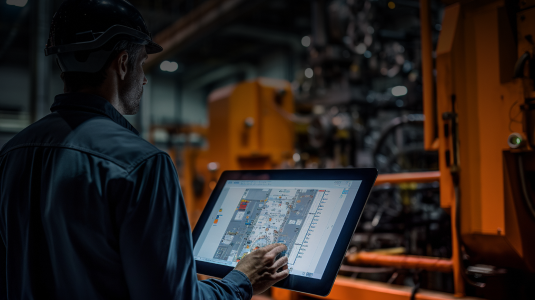Table of Contents
Design thinking process is a methodology focused on providing a solution-based approach to overcome problems. It is the best approach to overcome unknown, undefined, or unanticipated problems. This specific steps in design thinking process relies on the human ability to understand different patterns and develop emotionally appealing ideas that are meaningful and at the same time highly functional. This is a unique process and to implement it in the right way it is essential to partner with a web application development company.
An iterative approach, design thinking process is all about using different options and adapting to meet different needs. Considered as a repeatable process to solve problems and identify new opportunities, design thinking can be used for different types of solutions to align people’s needs to technical options and business needs.
While it is widely used by product designers, this human-centered approach to innovation is not limited to the creation of things. It follows processes such as deciphering human needs, analyzing problems in a human-centric manner, brainstorming ideas, and taking a head-on approach to prototyping and testing. Design thinking forms an important part of the web design and development process. Hire Web developers and designers to explore this phenomenon and ensure that this approach aligns with your user’s interests.
Design Thinking: Definition
“Design thinking” can be described as a discipline that uses the designer’s sensibility and methods to match people’s needs with what is technologically feasible and what a viable business strategy can convert into customer value and market opportunity.”
Difference between Human-Centered Design and Design Thinking
If you are going in circles and trying to figure out the core difference between Human-Centered Design and Design Thinking approaches, here is a quick answer. The aura and scope of design thinking are much wider compared to human-centered design. Design thinking is all about breakthrough innovation, as well as about developing new products, services, and solutions for problems.
The IDEO style “Design Thinking” refers to cognitive, strategic, and practical processes, with the final goal of which is to come up with innovative problems solving and the solutions to address a problem or meet a customer need. It is often applied to areas that are not traditionally defined as requiring design.
Design Thinking is largely not used by most companies or implemented in a haphazard manner, and most designers are not exclusively trained.
While human-centered design is all about improving usability and user experience of products or services. It is used to describe the process of designing for people and developing solutions involving the human perspective. So in a nutshell, it is all about human-centric designers and most UI/UX designers identify with HCD.
- Both methodologies are apt to handle the complex phases at the beginning of the innovation process, where uncertainty rules.
- User-centered with a heavy focus on empathizing with users.
- Both utilize creative and analytical thinking during the entire process of thinking and designing.
- Multidisciplinary teams with the ability to make people collaborate to maximize, support, and draw from different expertise.
What are the 5 Stages of Design Thinking?
Understanding these 5 design thinking process steps will empower users to apply Design Thinking methods to solve complex problems.
1. Empathise
This is the first stage of design thinking aimed at understanding needs, requirements, and objectives. Everything starts with observing and engaging with people to understand to build a connection at a psychological and emotional level. This stage involves setting aside assumptions and gathering actual preferences/or actionable insights about users.
2. Define
The second stage in the Design Thinking process is all about defining the actual problem. In this phase, all the information is gathered from the findings in the empathy stage and making sense.
- What difficulties and bottlenecks are users coming up against?
- Any specific patterns observed?
- What is the big user problem that needs to be solved?
The end of the defined phase will help you to build a clear problem statement in a user-centered way. Once you’ve devised the problem in words, you can come up with solutions and ideas — which brings us to the next stage.
3. Ideate
With solid research on user needs and problem statements, it is about time, to begin with, the Design Thinking process of working on potential solutions. This is the phase revolving around creativity and ideation. This stage will be about designers holding ideation sessions, exploring new ideas, and brainstorming. The end of this phase will help you come up with strong ideas to embark upon further.
4. Prototype
This is a phase where we can get experimental and transform ideas into products. The prototyping phase is developing a mini version of the product which also uses solutions identified in previous stages. This step is all about validating solutions identified, highlighting any limitations or obstacles. Throughout the stage of prototyping, the proposed solutions may be established, enhanced, revamped, or rejected depending on how they work in prototype form.
5. Test
After the stage of prototyping comes rigorous testing, but it’s worth noting that this is not the end of the Design Thinking process. In reality, the results of the testing phase will often push you back to introspect the steps crossed before, providing actionable insights to redefine the original problem statement or to come up with new ideas you hadn’t crossed your mind before.
Iterative and Non-linear Process
Design Thinking is an iterative process. It is all about constantly questioning the known to help define a problem as well as identify suitable alternative strategies that might not be visible based on the basic level of understanding. With this outside-of-box thinking, designers are attempting to develop new ways of thinking that defy challenges that are geared towards problem-solving methods.
Benefits of Design Thinking
Team Collaboration: Design thinking is all about innovation and increasing the level of collaboration among team members. With this concept, the focus is on putting users at the center point, gathering data, and collectively bringing innovative ideas for building better products/services.
Future Roadmap: The world of technology is disruptive and rapidly evolving. Design thinking allows the leaders to visualize things and build an empathy map to chart the direction for the future of companies. The visualization of the future with simplicity and clarity is important in the fast-changing business environment today.
Deep Understanding of Customers: It is important to keep yourself in customer’s shoes by putting the needs of users first. The core focus is on solving problems for the customers and not just creating products. The solutions are developed based on feedback and iterations.
Building Opportunities: Design thinking creates opportunities for everyone. It aims at building simpler products to improve usability and ultimately create more opportunities for everyone involved.
Launching Products & Services: The launch of your products/services is often fast-tracked using design thinking. It allows fewer surprises at the end. The customer feedback and iterations are already factored in during the development phase itself. It reduces last-minute surprises and risks. The products & services are also delivered in tune with the customer needs to maximize adoption.
Sales: Design thinking revolves around interactions with customers in a compelling way. Visual representation of solutions can help expedite the sales process as customers can understand the way the product works. When prospective clients can see the visualization of the solution, it is definitely easier to say yes.
Customer Touchpoints: The customer experience and their perception of your business matter a lot. Whether it is about getting information about a product or buying products or looking for support issues resolved, design thinking can be effectively used to create customer touchpoints.
Conclusion
The design thinking process steps are an iterative process offering flexibility and focused on collaboration between designers and users, with an emphasis on putting life into ideas based on how real users think, react, and behave.










































